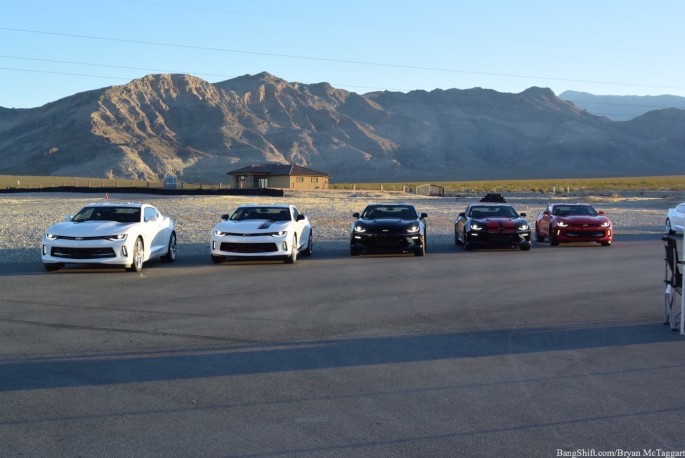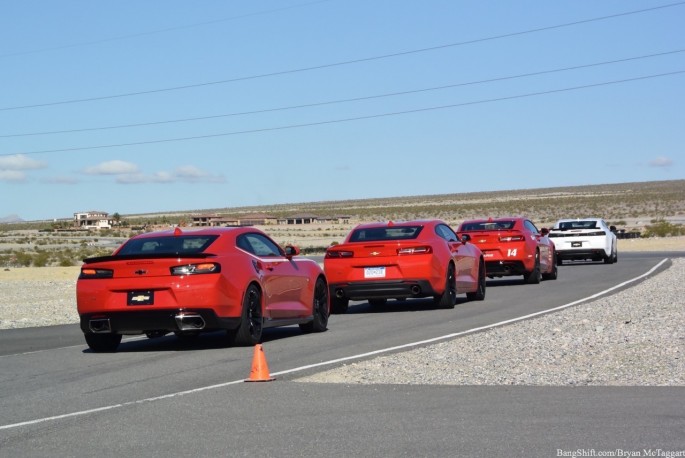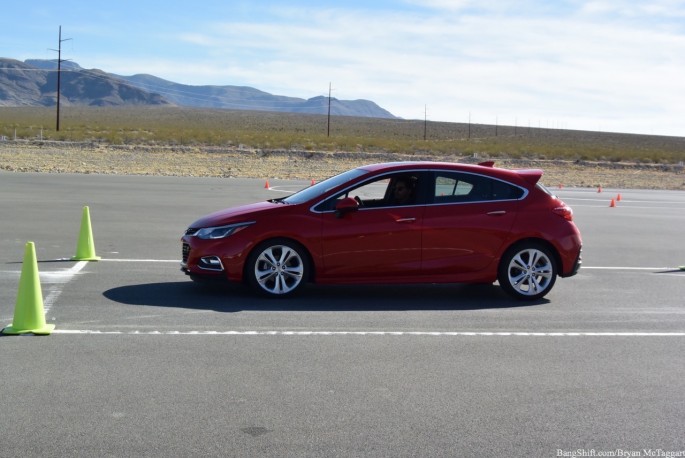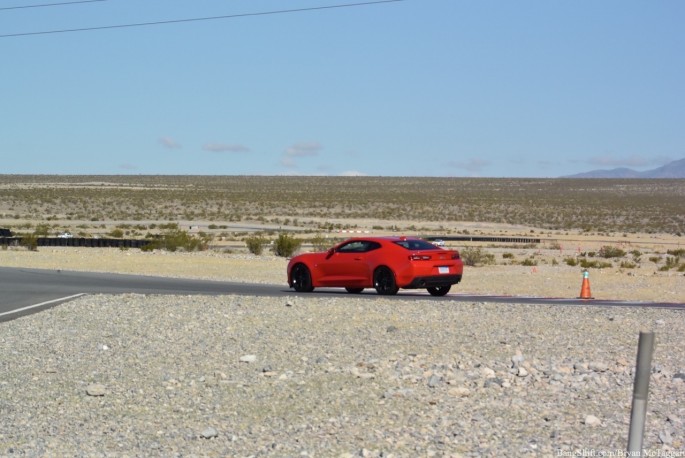If the SEMA coverage so far makes it sound like Lohnes and I had one hell of a week…well, we did. SEMA wasn’t even the start of our week…Lohnes was at Las Vegas Motor Speedway, where he got to see the number-one highlight video for 2016 in real life when Cruz Pedregon managed…somehow…to cross the beams on the rear tires with his Funny Car not only in a wheelie, but with the body seemingly acting like a wing, and I was out at Spring Mountain Motorsports Ranch in Pahrump, Nevada the day prior to the SEMA show actually kicking off. Wait…Pahrump? That’s at least an hour’s drive away from Vegas proper…what was I doing in the middle of nowhere? Easy: Spring Mountain Motorsports Ranch is a huge track complex, consisting of miles of racetrack. Chevrolet had commandeered a good section of the track because they wanted the people they invited out to, effectively, come beat on Camaros and Cruzes to see the difference between stock cars and Chevrolet Performance-modified versions.
Please, twist my arm.
Before we get to the track time, let’s review what I knew coming into this event: I’ve driven all three engines that sixth generation Camaros come with. The turbo-four is plenty adequate for what 85% of Camaro buyers are looking for, the 6.2L LT-1 V8 is a monster that can be civil, and the 3.6L LGX V6 is a big surprise, mainly because it’s acceleration will redefine what a V6 can actually do for you. None of these engines are penalty choices by any measures, but we had only driven them on the street and with automatics…nowhere even close to properly testing out their capabilities. The Cruze normally isn’t on our radar, but with the new Cruze Hatchback available for test driving the day we arrived at Spring Mountain, I couldn’t resist killing a bit of time and seeing what a basic new car could do. I did a review, but let me sum it up in short terms: I liked the feel, fit and finish, but the car overall made me yawn and the start-stop feature pissed me off. Hopefully auto crossing a Cruze would impress me more than the street-drive did.
What’s in the modified cars?
For our test day, we would be doing back-to-back testing: stock and modified Camaros would be making laps on Spring Mountain’s road course, following a driving instructor at about 80% capability of a good hot lap. For the Cruze, stock and modified cars would be running a pretty open autocross course with a stop box at the end of the run, two hot laps per run.
Now, we did say “modified” and that’s the truth: The Camaros were fitted with the SG3 lowering kit and SC1 handling kit that sourced parts from upper-eschelon, Brembo brake upgrade kits, and performance exhausts, as well as other various items from the Chevrolet Performance catalog, such as stripes, smoked clear taillights, and the like. There were V8s, V6s and turbo-fours with manual transmissions and at least one V8/automatic stocker in the fleet of cars that would be seeing track duty. For the auto crossing Cruzes, the modified cars would have the SG3 lowering kit, Brembo brake upgrades and a prototype performance exhaust that was being live-tested.
The SG3 lowering kits are interesting: For the Camaro, it’s a factory-designed system that is tuned to lower the Camaro to a level that most enthusiasts were already going for (about a 20mm drop) but instead of getting the harsh “lowered car” ride, that instead would ride like a factory stocker would…you know, comfortably. Shock tuning and spring rates were adjusted to meet the goals, and the teams that had designed the original suspensions found a spot that was extremely close to stock when it came to dampening and rebound. The Cruze’s kit is similar in design. Additionally, the Camaro’s SC1 suspension upgrade kit brings Camaro SS components to the four and six-cylinder cars: front and rear stabilizers and front steering links sharpen up the inputs and make the car more responsive…they said. Would those changes become apparent?
Enough technical talk. Let’s drive!
I drew the lucky straw Monday morning and found myself starting off with the Camaros on the track. For once, a Monday didn’t suck! I’m sure you were expecting me to hop into the first manual trans, V8-powered car I could get my mitts on…and you might be disappointed to know that’s precisely what I didn’t do. Instead, I wanted to flog the manual-trans V6 cars…after being shocked during my test-drive locally, I wanted to take the sixes out onto the track and flog the hell out of them. I’m going to review the cars in the reverse order I drove them, mainly because I want to provide a proper explanation on the differences…so let’s start with the stocker. Out of the box, the Camaro doesn’t suck. The LGX pulls hard, especially once you crest 3,500 and it’s happy to be beat on. But the suspension allows for a bit more body roll than I’d appreciate on a road course and the brakes, while adequate, didn’t inspire confidence, especially after getting some heat into them. By comparison, the modified V6 was simply on: compared to the stocker, the car was almost pleading with me for more. It’d turn in sharper, bite harder, scream out of the corner with authority and a proper noise, and the brakes…the brakes alone are worth the cost of the upgrade. Compared with the stockers, I did not sweat the brakes at all, no matter how hard I pushed the car.
We were running 80% capability on the track for a couple of reasons: the pavement was cold, the pavement was dusty, and going off of the asphalt meant that you were driving straight into rocky, Death Valley desert. No bueno…there might not have been a wall to stop us, but those rocks would’ve eaten a tire and wheel package without mercy. But we were moving quick enough that Chevrolet insisted that we wear helmets and HANS devices, and trust me, I was hustling plenty fast (the V8 car was pushing about 115 MPH at the end of the long straight into a right-handed sweeper.) Each car got you three good laps, and I turned plenty to know that the modified V6/manual trans car is the one for me. The stocker V8/automatic made a nice noise and was plenty tail-happy, but the weight of the engine was working against the front suspension pretty hard, and the turbo-four manual I drove after it’d done several laps, so when I went diving into that first right-hand sweeper after the straightaway, the car turned in, set…then promptly slid off, dropping the left wheels into the dirt. I might have been a touch hot in the corner, but luckily after a quick look-over we found that the Camaro suffered no ills and was immediately put back out on track.
So, what about the Cruze?
 The last time I autocrossed a front-drive Chevy, it was a 2006 Monte Carlo SS…one of the LS4-powered beasts, a car most unhappy with turning at speed. When I autocrossed it at Bremerton Raceway in Washington State, that car threatened several times to completely ignore the idiot at the wheel and make a beeline for the nearest scotch broom thicket. The Cruze, by comparison, should be light and tossable, but the power of the four-cylinder hadn’t quite impressed me on the open-road adventure I had taken the day prior, and to add to my apprehension, all of the cars were automatics. I had been hoping that there were manual-transmission Cruzes, but oh, well. First up was the stockers, and after the first lap a couple of things came to mind: the Cruze might be a dog off of the line (blame turbo lag) but once that engine comes on, it will move; the computers don’t like adding in any power when the wheels are turning; and the brakes, even in the stockers, are surprisingly awesome…if you powered out of the final corner towards the stop box right, you were pushing the upper end of first gear and slamming the brakes earned you a RIGHT FREAKING NOW stop.
The last time I autocrossed a front-drive Chevy, it was a 2006 Monte Carlo SS…one of the LS4-powered beasts, a car most unhappy with turning at speed. When I autocrossed it at Bremerton Raceway in Washington State, that car threatened several times to completely ignore the idiot at the wheel and make a beeline for the nearest scotch broom thicket. The Cruze, by comparison, should be light and tossable, but the power of the four-cylinder hadn’t quite impressed me on the open-road adventure I had taken the day prior, and to add to my apprehension, all of the cars were automatics. I had been hoping that there were manual-transmission Cruzes, but oh, well. First up was the stockers, and after the first lap a couple of things came to mind: the Cruze might be a dog off of the line (blame turbo lag) but once that engine comes on, it will move; the computers don’t like adding in any power when the wheels are turning; and the brakes, even in the stockers, are surprisingly awesome…if you powered out of the final corner towards the stop box right, you were pushing the upper end of first gear and slamming the brakes earned you a RIGHT FREAKING NOW stop.
By comparison, the modified car did two things better: it sounded better, and the steering issue seemed just a touch less intrusive, which seemed to get better when I started driving two-footed. But the brakes…dear lord, the brakes on the modified Chevy Cruze were the kind that you heap praise on. Chirp-chirp-STOP. Literally, that quick. I actually undershot the stop box my first run in the modified car. If Chevy can dial out the turbo lag and give the car some down-low grunt, the Cruze could actually be a threat to the Ford Fiesta ST crowd at autocrosses.
What did we learn?
The overall vibe we got from our trip to Spring Mountain is that gearheads still live within Chevrolet. Making a Chevrolet Cruze dance on a course like the modified cars did is impressive. Improving on an already good product like the Camaro by using factors learned from fifth-generation owners is smart engineering. Add in the twenty-one concept cars on the SEMA floor, and the Drag Performance test cars that we got to look at, and you can tell that there’s an element within Chevrolet that wants to help owners turn their cars into something more. We dig the movement, and we like what we saw. We weren’t pussyfooting around…the only reason we weren’t completely cut loose was for safety reasons and nothing more. We’d like to see more of this factory-tuner attitude applied to more vehicles (namely, the truck lines and the SS sedan) but as it stands, Chevrolet certainly has a good thing going.



















Truly didn’t suck to be you those days. Sounds like you had a blast, cool!